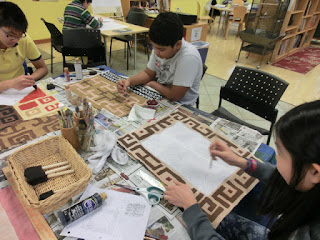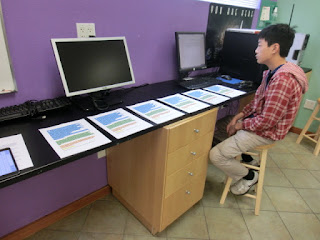HS Students are surprised by the complexities of this art form
Kuba cloth is typically woven from raffia and features repeating geometric shapes, some of which are symbolic, but it is largely decorative. In the classroom we emulated the look of Kuba by using textile and paint.
 |
| First the students were required to plan their approach using a miniature sketch of their project. |
 |
| Repeating blocks of patterns are a key feature of Kuba. Collectively, when paired in contrasting patterns, the effects can be striking. |
 |
| Although the traditional palette for Kuba is based on earth and neutral tones, color can feature too! |
 |
| Some students opted for borders; others for large blocks of contrasting shapes and colors. |
 |
| We also worked on our regular lessons during this big project. Here our Chinese students are practicing English verbs. |
 |
| We found that the hardest part was getting started. White textile is not forgiving of mistakes! |
 |
| The overall effects came together quickly once we started putting color on our textile. |
 |
| And - we continue to work on Spring Festival. Here we are collating scripts so people can start learning their parts! |

Nice report!
ReplyDelete